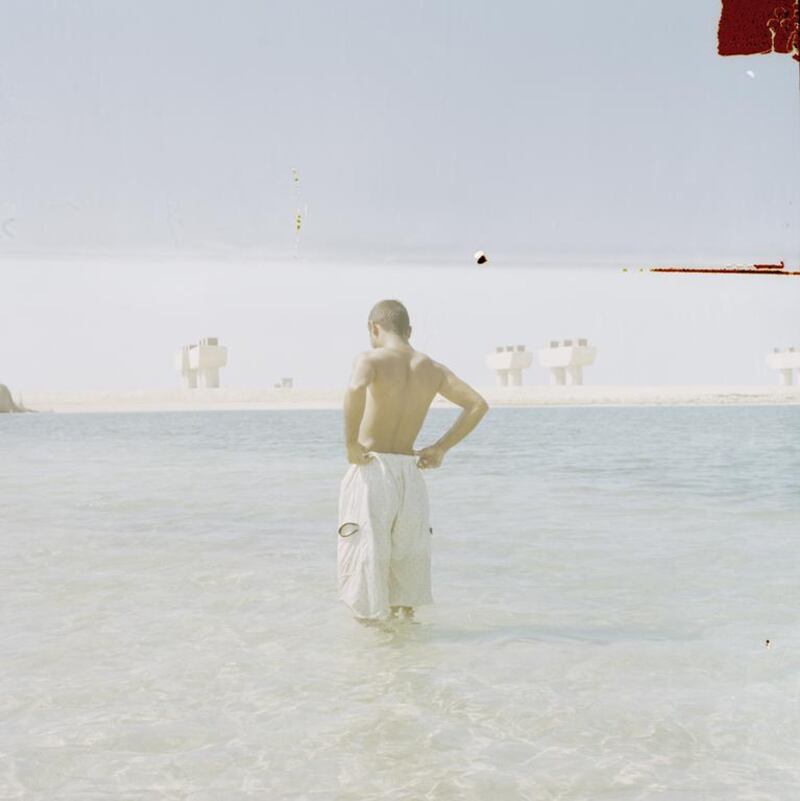When you see somewhere you know through someone else’s eyes, it’s impossible not to judge the tone and tenor of their vision and to try to match it with your own.
That’s certainly the case with Olivia Arthur’s work, which was exhibited by Dubai’s Cuadro Gallery as part of this week’s Warehouse421 and Abu Dhabi Art’s Galleries Week, held in Mina Zayed.
Part of a wider project titled Stranger, Arthur's photograph was suitably maritime and local for an art fair held on the margins of a port and dhow harbour.
The picture features a young South Asian man standing in the sunlit waters of a shallow sea, and for anyone familiar with Dubai’s interstitial spaces, the totemic pillars in the photograph’s background immediately reveal its location – the beach at the base of the incomplete and abandoned Palm Jebel Ali.
The real difference however, between Arthur’s bleached and beguiling image and so many of the photographs that are currently taken of the UAE is that rather than falling into the trap of making trite and didactic statements – about migrant labour, the UAE’s culture of excess or its unbridled urbanisation – it raises more questions than answers: just how old is the picture; what is the man doing; and what, if anything, does the image mean?
Stranger by Olivia Arthur from Fishbar Books on Vimeo.
The product of a three-month-long artist's residency sponsored by Fairmont The Palm and Project Encounter, that Arthur undertook in 2013 and 2014, Stranger takes an episode from Dubai's recent history as its starting point – a maritime disaster whose 56th anniversary took place on April 8.
On that date in 1961, MV Dara, a British India Line steamship that used to ply its trade between Bombay and Karachi, Bahrain and Basra, sank in the waters off the coast of Dubai.
The deadliest disaster in the Gulf’s peacetime maritime history, an estimated 238 lives were lost. Some of the victims’ bodies were recovered from the shallow waters, but some were not. Among the families of those missing, there are still relatives who hold out the hope that their loved ones will return.
"What if someone could have survived on an island in the Gulf?" Arthur asks in the 224-page book and nine-minute film that are the key components of Stranger. "What would they see if they came to the city now, 50 years later?"
“I was totally fascinated by the idea and by that belief, that you could continue to look for someone, after 50 years,” the photographer tells me from her studio in London.
"But Stranger isn't about those families or the victims; they're just a starting point that allows people to interpret things in different ways, and I think that's more interesting," she says.
Arthur is one of only nine living female photographers to belong to Magnum Photos, the prestigious agency founded at New York’s Museum of Modern Art (Moma) in 1947 by Robert Capa, Henri Cartier-Bresson, George Rodger and David Seymour.
The agency community will celebrate its 70th anniversary this summer with an exhibition at Moma in June, where Arthur's film from Stranger, not yet screened in the UAE, will form a key part.
Despite its association with a haunting story, none of the images used in Stranger are staged, including those that Arthur took when she eventually dived down to see the wreck, which now rests 20 kilometres off the coast.
The context of Arthur’s documentary images however, affords them a dreamlike quality that allows them float between fiction and fact, questioning their relationship with reality.
“At what point can you change what something means by placing it in a different context?,” she asks.
“For some people it might be about the way they set their photographs up, but can also be about the context you set them in and the way you put them out.”
As a body of work, Stranger is not the first time Arthur has adopted a strategy of placing documentary images within a conceptual framework. Her first major project, Jeddah Diary, used a similar technique to examine the experience of women in another port town on the other side of the Arabian Peninsula.
“Both Dubai and Jeddah are misunderstood places. They have lots of different worlds within them and I think that makes it quite hard to talk about them,” she explains.
“If you do it in a straightforward documentary way and say ‘this place is like this’, then it will be misleading because it won’t represent the complexity of the place, so that’s why I ended up with the work that I have.”
Nick Leech is a features writer at The National.





